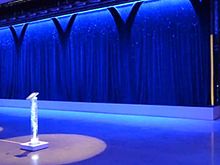Watergraphic
Watergraphic refers to a writing water wall within the stage technology with which one can create any pictures and writing from water.
difference
While with the waterscreen technology the water simply falls down following the force of gravity and only allows a complete or segment-wise slow switching on and off, with the Watergraphic individual water jets are switched on and off very quickly under computer control. With the appropriate control technology, it is possible to display contrast images (black / white). These fall inexorably downwards according to their initial speed and mass according to the acceleration factor.
Representations
The presentation is based on simple black and white raster graphics . A high contrast and a lack of detail is essential. Images or complex logos usually fail because of the economically still feasible horizontal display width (pixels). It is an effect and not a substitute for video or laser projection . It is not possible to create still images, because the entire image content is always changed or renewed and not just a small part, as is the case with the waterscreen with projection.
history
Since the creation of the first types around 1989, some companies have brought prototypes to series production and ready for event use. Since 2006, valve opening and closing times of less than 4 ms (which corresponds to 250 lines per second) according to the current state of the art, the physical upper speed limit has been reached. The horizontal resolution has also become significantly better in series-produced models with 96 pixels per meter compared to the initial models with 20 pixels per meter. Horizontal resolutions of up to 1,536 pixels wide (which corresponds to 32 m or 16 m image width) are possible.
At the Expo 2008 in Saragossa , Spain, four systems from different manufacturers were on display for the first time, which are the same in their basic function, but differ greatly in resolution and technology. Round systems and 3D systems have also been available since mid-2008. In Germany, the term watergraphic has established itself as a collective term.
technology
Water jet shape
There are two types here: single beams, i.e. H. each mostly thick beam is switched on and off individually. Clear and sharp contours can be drawn with it. On the other hand, fine sprinkling, in which the switched jet after the valve is again divided into several jets. This then leads to a more closed spray pattern, but due to the delays caused by the division into partly extremely blurred contours.
The water switch
Commercially available solenoid valves for water are mostly used. There are also plug pulling systems or sealing stamp systems or even valves for actually pneumatic applications.
Controls: on and off
A distinction is made here between conventional power-on to excite the solenoid coil until it is triggered after approx. 15-17 ms and high-speed control, with which the trigger point is reached much faster after approx. 4 ms.
Computer control
Most manufacturers use commercially available PLC industrial controls. Since these quickly reach their limits (number of channels and possible switching functions at the same time), specially developed computer and bus systems are used, especially for high-speed systems.
While programming was initially very complex, there are now systems that convert simple bitmap graphics. Some water walls can even be programmed "live" using a tablet PC.





